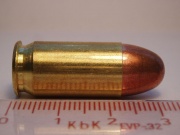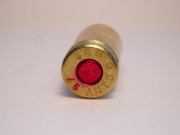Difference between revisions of ".45 ACP"
(→References) |
m (1 revision) |
Revision as of 14:23, 15 March 2013
| .45 ACP | |||||||||||||||||||
|---|---|---|---|---|---|---|---|---|---|---|---|---|---|---|---|---|---|---|---|
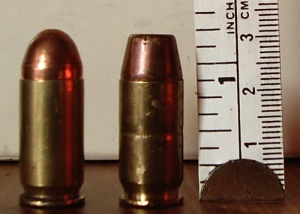
| |||||||||||||||||||
| .45 ACP cartridges | |||||||||||||||||||
| Type | Pistol | ||||||||||||||||||
| Country of Origin | USA | ||||||||||||||||||
| Specifications | |||||||||||||||||||
| Case Type | Rimless, straight | ||||||||||||||||||
| Bullet Ø | .451 in (11.5 mm) | ||||||||||||||||||
| Neck Ø | .473 in (12.0 mm) | ||||||||||||||||||
| Base Ø | .476 in (12.1 mm) | ||||||||||||||||||
| Rim Ø | .480 in (12.2 mm) | ||||||||||||||||||
| Case Length | .898 in (22.8 mm) | ||||||||||||||||||
| Full Length | 1.260 in (32.0 mm) | ||||||||||||||||||
| Primer | Large pistol | ||||||||||||||||||
| Production & Service | |||||||||||||||||||
| Designer | John Browning | ||||||||||||||||||
| Design Date | 1904 [1] | ||||||||||||||||||
| Manufacturer | numerous | ||||||||||||||||||
| Production Dates | 1905-present | ||||||||||||||||||
| In Service | 1911-present | ||||||||||||||||||
| Used By | United States & allies; others | ||||||||||||||||||
| Wars | nearly all conflicts since WWI | ||||||||||||||||||
| Ballistic Performance Sampling | |||||||||||||||||||
| |||||||||||||||||||
The .45 ACP would become one of the most successful cartridges of all time, among both military and civilian users. It has been used in innumerable handguns and submachine guns since its introduction.
Contents |
Design & History
The US Cavalry had been buying and testing various handguns in the late 1890s and early 1900s. The .45 Colt Single Action Army had largely been replaced, even by some double action versions of the same. The Cavalry had fielded some double action revolvers in .38 Long Colt, and they determined that the .38 caliber round was significantly less effective against determined opponents, such as those encountered in the Moro Rebellion warriors they were fighting at the time of the Philippine-American war, than the .45 Colt. The current issue rifle at the time, the .30-40 Krag, also had failed to stop Moro warriors;[3] the British had similar issues switching to the .303 British, which resulted in the development of the Dum-dum bullet. This experience, and the Thompson-LaGarde Tests of 1904 led the Army and the Cavalry to decide that a minimum of .45 caliber was required in the replacement handgun.Colt had been working with Browning on a .41 caliber cartridge in 1904, and in 1905 when the Cavalry asked for a .45 caliber equivalent Colt modified the pistol design to fire a .45 caliber version of the prototype .41 caliber round. The result from Colt was the Colt Model 1905 and the new .45 ACP. The original round that passed the testing fired a 200 grain (13 g) bullet at 900 ft/s (275 m/s), but after a number of rounds of revisions between Winchester Repeating Arms, Frankford Arsenal, and Union Metallic Cartridge, it ended up using a 230 grain (15 g) bullet at about 850 ft/s (260 m/s). The resulting .45 caliber cartridge, named the .45 ACP, is similar in performance to the .45 S&W cartridge, and only slightly less powerful (but significantly shorter) than the .45 Colt cartridges the Cavalry was using. The cartridge case shared the same head dimensions as the .30-03 and later .30-06 rifle cartridges in use by the military at the time.
By 1906 bids from 6 makers were submitted, among them Browning's design, submitted by Colt. Only DWM, Savage, and Colt made the first cut. DWM, which submitted two Luger pistols adapted to the .45 ACP cartridge, withdrew from testing after the first round of tests, for unspecified reasons.[4] One of the DWM pistols, serial number 1, was destroyed in testing; the remaining instance, serial number 2, is considered one of the most desirable collectors handguns in existence.[5]
In the second round of testing in 1910, the Colt design passed the extensive testing with no failures, while the Savage design suffered 37 stoppages or parts failures.[4] The resulting Colt design was adopted as the Model 1911.
Performance
The result is one of the world's more effective combat pistol cartridges, one that combines very good accuracy and stopping power for use against human targets. The cartridge also has relatively low muzzle blast and flash, as well as moderate recoil. The .45ACP also operates at a relatively low maximum chamber pressure rating of 21,000 psi (145 MPa) (compared to 35,000 psi/240 MPa for 9mmP and .40S&W, 37,500 psi/260 MPa for 10mmAuto, 40,000 psi/280 MPa for .357SIG), which helps extend service life of weapons it is fired in.
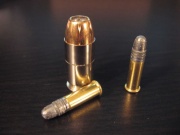
Like many pistol cartridges, it is a low-velocity round, and thus not particularly effective against body armor. Another drawback for large scale military operations is the cartridge's large size, weight, the increased material cost of manufacture compared to the smaller 9x19mm Parabellum cartridge, and lack of compliance with Standardization Agreements pertaining to handgun ammunition currently enacted between the US and many of its allies.
Even in its non-expanding full metal jacket (FMJ) version, the .45 ACP cartridge has a reputation for effectiveness against human targets because its large diameter creates a deep and substantial permanent wound channel which lowers blood pressure more rapidly. However, some writers, such as the published work of Marshall and Sanow, have cast the reputation of .45 ACP as being the "best" at this task into debate. Marshall & Sanow's work, while receiving heavy criticism from Dr. Fackler and others, show the .45 ACP, loaded with the best hollowpoint bullets and fired from a 5" barrel to be a good "one shot stopper", somewhat better than the 9x19mm, equal with the .40 S&W, and only a few percentage points behind the "King" of the Marshall and Sanow study - the .357 Magnum fired from a 4" barrel. Nevertheless, the .45 ACP remains one of the top handgun cartridges for stopping power, when figures are compiled accurately.
Being a moderate-powered cartridge, the wide diameter of the .45 ACP bullets produces a decreased tendency to overpenetrate, which reduces the projectile's possibility of passing through the intended target with enough velocity to injure another person. The combination of stopping power and controlled penetration makes the .45 ACP practical for police use, although numerous issues, including the resulting decrease in magazine capacity and the larger size and weight of pistols chambered in this caliber, have led more police departments in the USA to adopt sidearms in 9x19mm, .40 S&W, and .357 SIG.[6] Many US tactical police units still utilize the .45 pistol round, including the FBI's Hostage Rescue Team.[7][8][9] While high capacity firearms are available in .45 ACP, the greater length and diameter of the .45 ACP means that the grip of the pistol must be longer and wider than the grip of a comparable pistol of a smaller caliber; this increase in grip size can make the pistol difficult to use for shooters with smaller hands.
Today most NATO militaries use sidearms chambered for the 9x19mm Parabellum cartridge, but the effectiveness of the .45 ACP cartridge has ensured its continued popularity with large caliber sport shooters, especially in the United States. In addition, select military and police units around the world still utilize firearms firing the .45 ACP.
Because all standard .45 ACP rounds fired from handguns or short barreled "submachine" guns are inherently subsonic, it is one of the most powerful pistol calibers available for use in suppressed weapons since subsonic rounds are quieter than supersonic rounds. The latter inevitably produce a highly compressed shockwave, audible as a loud "crack", literally a small sonic boom, while they travel through the air. Suppressors reduce the audible "report" by slowing and channeling the high speed gas generated by the burning/expanding gunpowder before it exits the muzzle resulting in a muffled "cough". Suppressors of course can't act on a supersonic shockwave generated by the bullet breaking the 1,100 ft/s (340 m/s) sound barrier as this happens after it exits the barrel. The downside to the use of .45ACP in suppressed weapons is that increasing the diameter of the passage through a suppressor decreases its efficiency - thus, while .45ACP is among the most powerful suppressed pistol rounds, it is also one of the loudest. Most .45 suppressors must be fired "wet" (with an ablative medium, usually water) to bring sound levels down to "hearing-safe" (under 140dB, generally).
Load variants
Several manufacturers market preloaded .45 ACP rounds in sizes ranging from 117 to 230 grains (8 g to 15 g), with the most popular commercial load being the standard military loading of a 230-grain (15 g) FMJ bullet at around 850 ft/s (260 m/s). Specialty rounds are available in weights under 100 grains (6.5 g) and over 260 grains (16.8 g); popular rounds among reloaders and target shooters include 185-and 230-grain (12 g and 15 g) bullets. Hollow-point rounds intended for maximum effectiveness against live targets are designed to expand upon impact with soft tissue, increasing the size of the permanent cavity left by the bullet as it passes through the target.
Most ammunition manufacturers also market what are termed "+P" loadings in pistol ammunition, including the .45 ACP. This means the cartridge is loaded to a higher maximum pressure level than the original SAAMI cartridge standard, generating higher velocity and more muzzle energy. In the case of the 45 ACP, the standard cartridge pressure is 21,000 PSI and the SAAMI 45 ACP +P standard is 23,000 PSI. This is a common practice for updating older cartridges to match the better quality of materials and workmanship in modern firearms.
The terminology is generally given as ".45 ACP +P", and appears on the headstamp. It is important to note that +P cartridges are dimensionally identical to standard-pressure cartridges and will chamber and fire in all firearms designed for the standard-pressure loadings. However, if +P loadings are used in firearms not specifically designed for them they may cause damage and injuries to the operator.
Popular derivative versions of the of the .45 ACP are the .45 Super and .460 Rowland. The Super is dimensionally identical to the .45 ACP, however, the cartridge carries a developer established pressure of 28,500 PSI and requires minor modification of quality firearms for use. The Rowland case is 0.057" longer specifically to prevent it from being chambered in standard .45 ACP firearms. The Rowland operates at a developer established 40,000 c.u.p. and may only be used within a select group of firearms signficantly modified for this purpose. Brass cases for each of these cartridges carry the applicable name within the headstamp. The Super provides approximately 20% greater velocity than the .45 ACP +P, the Rowland approximately 40% greater velocity than the .45 ACP +P.
Timeline
- 1899/1900 self-loading pistols test: Colt M1900 of .38 caliber entered
- 1904 Thompson-LaGarde Tests: Caliber of new handgun should be at least .45
- 1906–1907 handgun trials: Colt enters with .45 ACP design
- 1910 final tests: Colt pistol (designed by John Browning) out-performs Savage
- On March 29 1911, the Colt pistol is officially adopted as the Model 1911 - and with it, the .45 ACP cartridge.
Synonyms
- .45 Auto
- 11.43 x 23 mm
Martial firearms using the .45 ACP
- Colt M1911 & M1911A1 pistol
- Thompson submachine gun
- M1917 revolver
- Reising submachine gun
- M3 "Grease Gun" submachine gun
- FP-45 Liberator pistol
References
- ↑ The .45 ACP approaches its centennial - Handguns | Guns Magazine | Find Articles at BNET.com
- ↑ Federal Cartridge Co. Ballistics page
- ↑ 1911 History
- ↑ 4.0 4.1 Background
- ↑ Luger comment
- ↑ (modern versions of .45 ACP handguns have high capacity magazines capible of holding as many as 14 cartridges such as the Springfield XD.) Choose your ammo ... police style - Ayoob, Massad; Backwoods Home Magazine
- ↑ Diez, Octavio. Special Police Task Forces. Lima Publications, 40.
- ↑ Hogg, Ian. Jane's Gun Regonition Guide, 2nd Edition.. Harper Collins Publishers, 113.
- ↑ Most Wanted American Handgunner. Publishers Development Corporation.
- Marshall, EP, Sanow, EJ: "Street Stoppers: The Latest Handgun Stopping Power Street Results", Paladin Press, Boulder, Colorado, 1996.
- Massad Ayoob's 2003 article on the approaching 100th anniversary of the .45 ACP
- The Thompson-LaGarde Cadaver Tests
Video
| This article is part of a series on the works of John Moses Browning | ||
|---|---|---|
| Semi-automatic pistols | FN M1900 · Colt M1900 · Colt M1902 · FN Model 1903 · M1903 Pocket Hammer · M1903 Pocket Hammerless · M1908 Vest Pocket · FN Model 1910 · M1911 · Colt Woodsman · Baby Browning · Hi-Power | 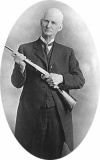 |
| Rifles | Winchester Model 1885 · Winchester Model 1886 · Winchester 1892 · Winchester Model 1894 · Winchester Model 1895 · Remington Model 8 · Remington Model 24 · FN Trombone | |
| Shotguns | Winchester Model 1887 · Winchester Model 1897 · Browning Auto-5/Remington Model 11 · Remington Model 17 · Savage Model 520 · Browning Superposed · Ithaca 37 | |
| Machine guns | Colt-Browning M1895 · Browning M1917 · Browning Automatic Rifle · Browning M1919 · M2 Machine Gun | |
| Cartridges | .25 ACP · .32 ACP · .38 ACP · .380 ACP · .45 ACP · .50 BMG | |

